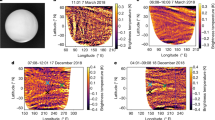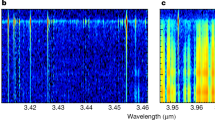Abstract
The planet Venus is covered by thick clouds of sulfuric acid that move westwards because the entire upper atmosphere rotates much faster than the planet itself. At the cloud tops, about 65 km in altitude, small-scale features are predominantly carried by the background wind at speeds of approximately 100 m s−1. In contrast, planetary-scale atmospheric features have been observed to move slightly faster or slower than the background wind, a phenomenon that has been interpreted to reflect the propagation of planetary-scale waves. Here we report the detection of an interhemispheric bow-shaped structure stretching 10,000 km across at the cloud-top level of Venus in middle infrared and ultraviolet images from the Japanese orbiter Akatsuki. Over several days of observation, the bow-shaped structure remained relatively fixed in position above the highland on the slowly rotating surface, despite the background atmospheric super rotation. We suggest that the bow-shaped structure is the result of an atmospheric gravity wave generated in the lower atmosphere by mountain topography that then propagated upwards. Numerical simulations provide preliminary support for this interpretation, but the formation and propagation of a mountain gravity wave remain difficult to reconcile with assumed near-surface conditions on Venus. We suggest that winds in the deep atmosphere may be spatially or temporally more variable than previously thought.
This is a preview of subscription content, access via your institution
Access options
Access Nature and 54 other Nature Portfolio journals
Get Nature+, our best-value online-access subscription
$29.99 / 30 days
cancel any time
Subscribe to this journal
Receive 12 print issues and online access
$259.00 per year
only $21.58 per issue
Buy this article
- Purchase on SpringerLink
- Instant access to full article PDF
Prices may be subject to local taxes which are calculated during checkout



Similar content being viewed by others
References
Nakamura, M. et al. Overview of Venus Orbiter, Akatsuki. Earth Planets Space 63, 443–457 (2011).
Fukuhara, T. et al. LIR: Longwave Infrared Camera onboard the Venus Orbiter Akatsuki. Earth Planets Space 63, 1009–1018 (2011).
Taguchi, M. et al. Characteristic features in Venus’ nightside cloud-top temperature obtained by Akatsuki/LIR. Icarus 219, 502–504 (2012).
Esposito, L. W. et al. in Venus (eds Hunten, D. M., Colin, L., Donahue, T. M. & Moroz, V. I.) 484–564 (Univ. Arizona Press, 1983).
Nakamura, M. et al. AKATSUKI returns to Venus. Earth Planets Space 68, 75 (2016).
Taguchi, M. et al. Longwave Infrared Camera onboard the Venus Climate Orbiter. Adv. Space Res. 40, 861–868 (2007).
Rossow, W. B. et al. Cloud morphology and motions from Pioneer Venus images. J. Geophys. Res. 85, 8107–8128 (1980).
Del Genio, A. D. & Rossow, W. B. Planetary-scale waves and the cyclic nature of cloud top dynamics on Venus. J. Atmos. Sci. 47, 293–318 (1990).
Ogohara, K. et al. Automated cloud tracking system for the Akatsuki Venus Climate Orbiter data. Icarus 217, 661–668 (2012).
Ikegawa, S. & Horinouchi, T. Improved automatic estimation of winds at the cloud top of Venus using superposition of cross-correlation surfaces. Icarus 271, 98–119 (2016).
Bertaux, J.-L. et al. Influence of Venus topography on the zonal wind and UV albedo at cloud top level: the role of stationary gravity waves. J. Geophys. Res. 121, 1087–1101 (2016).
Lindzen, R. S. Turbulence and stress owing to gravity wave and tidal breakdown. J. Geophys. Res. 86, 9707–9714 (1981).
Schubert, G. in Venus (eds Hunten, D. M., Colin, L., Donahue, T. M. & Moroz, V. I.) 681–765 (Univ. Arizona Press, 1983).
Seiff, A. et al. Measurements of thermal structure and thermal contrasts in the atmosphere of Venus and related dynamical observations: results from the four Pioneer Venus probes. J. Geophys. Res. 85, 7903–7933 (1980).
Smith, R. B. Linear theory of stratified hydrostatic flow past an isolated mountain. Tellus 32, 348–364 (1980).
Imamura, T. Meridional propagation of planetary-scale waves in vertical shear: implication for the Venus atmosphere. J. Atmos. Sci. 63, 1623–1636 (2006).
Schubert, G. & Walterscheid, R. L. Propagation of small-scale acoustic-gravity waves in the Venus atmosphere. J. Atmos. Sci. 41, 1202–1213 (1984).
Crisp, D. Radiative forcing of the Venus mesosphere II. Thermal fluxes, cooling rates, and radiative equilibrium temperatures. Icarus 77, 391–413 (1989).
Acknowledgements
We would like to acknowledge all the members of the Akatsuki project team for their efforts in the Akatsuki operation, which led to the successful VOI. This work was supported by JSPS KAKENHI Grant Numbers JP15K17767 and JP16H02231.
Author information
Authors and Affiliations
Contributions
M.T. and S.W. are the principal investigators of LIR and UVI, respectively. T.F., M.F., G.L.H., T.I., N.I., T.K., M.N., M.S., T.M.S., M.S., S.T. and M.U. are co-investigators of LIR. M.Y. and A.Y. are co-investigators of UVI. T.H., S.-y.M. and K.O. contributed to the derivation of the wind field. T.I. contributed to the numerical modelling.
Corresponding author
Ethics declarations
Competing interests
The authors declare no competing financial interests.
Rights and permissions
About this article
Cite this article
Fukuhara, T., Futaguchi, M., Hashimoto, G. et al. Large stationary gravity wave in the atmosphere of Venus. Nature Geosci 10, 85–88 (2017). https://doi.org/10.1038/ngeo2873
Received:
Accepted:
Published:
Issue Date:
DOI: https://doi.org/10.1038/ngeo2873



